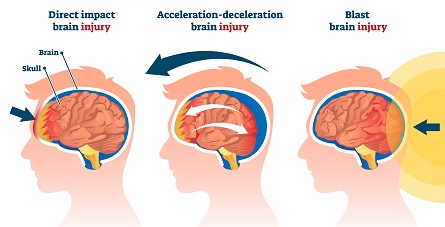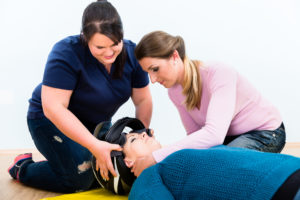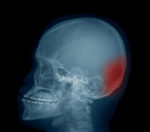Head injuries must be treated with the utmost care. The skull, or cranium, contains one of the main components of the Central Nervous System – the brain. The brain controls most things that happen in the body, and any damage to it could be fatal.
Concussion
Concussion is one of the most common types of head injury. It is where the brain goes through some sort of trauma. There are three main types of concussion injury, and these will all depend on the mechanism of injury:
- Direct Impact – This is where the front of the brain (typically the frontal lobe) crashes into the skull.
- Acceleration-Deceleration – Like a Direct Impact injury, the brain hits the front of the skull but then it ricochets and hits the back of the skull as well. Therefore two parts of the brain are affected.
- Blast – These affect a large proportion of the brain as it is caused by waves from an explosion. These are normally associated with other blast injuries which you can find out more about by following the link.

Concussion Symptoms
Concussion symptoms can be very varied depending on the type of concussion and how serious it is. Less serious symptoms – which usually do not require medical help – include:
- A light headache which does not stay for too long
- Slight nausea
- Slight dizziness
However, should any of those symptoms worsen or persist, or include any of the following, it is essential to either visit A&E or call the Emergency Medical Services.
- Unconsciousness or difficulty keeping conscious
- Amnesia
- Vomiting
- Loss of feeling in any area of the body
- Fits or seizures
- Any fluid (blood or clear) coming out of the nose or ears
- Vision problems
- A black eye
- If you have ever had any brain operation, have been drinking alcohol, using drugs, or are taking blood-thinners.
Other Head Injuries
There are many other head injuries and some do not have a mechanism of injury – they just happen.
- Stroke
- Fainting
- Bleed on the brain
- Cerebral Contusion
- Cerebral Compression
- Nosebleeds
- Foreign objects
- Broken Skull
Spinal Injuries
Any trauma to the head could have an impact on the spinal column since they are connected. Like the brain, the spinal column comprises the other part of the Central Nervous System, and any damage to that could have life-long effects. Therefore, as a First Aider, you must be sure that they have not damaged their spine as well when they become injured. If you think they may have, make sure to urge them not to move their head at all, and only if you are trained to do so, move their head into neutral alignment.
Helmets
Finally, it is worth mentioning what to do if the patient is wearing a helmet. These are very good ways of reducing head injuries and they are best left on. If you remove them haphazardly, you could end up causing more damage, especially if they have spinal injuries. You may have to remove it however if you cannot maintain their airway, or if they cannot breathe.

If you do need to remove the helmet, you must do it slowly and carefully, ideally with two people. First, make sure you remember to remove the strap and have a good look to see what you are going to do. Then, one person holds the helmet and the other supports the neck as the helmet is removed. Keep the helmet close – because it will usually go with the patient to the hospital. This is due to the possible marks on the helmet being an indicator of what happened – and what injuries they may have sustained.
For more information on training courses, visit our “Courses” page which also includes our First Responder and First Person on Scene (FPOS) Courses.


Pingback: Haemocap - First Aid Wiki
Pingback: Epilepsy - First Aid Wiki